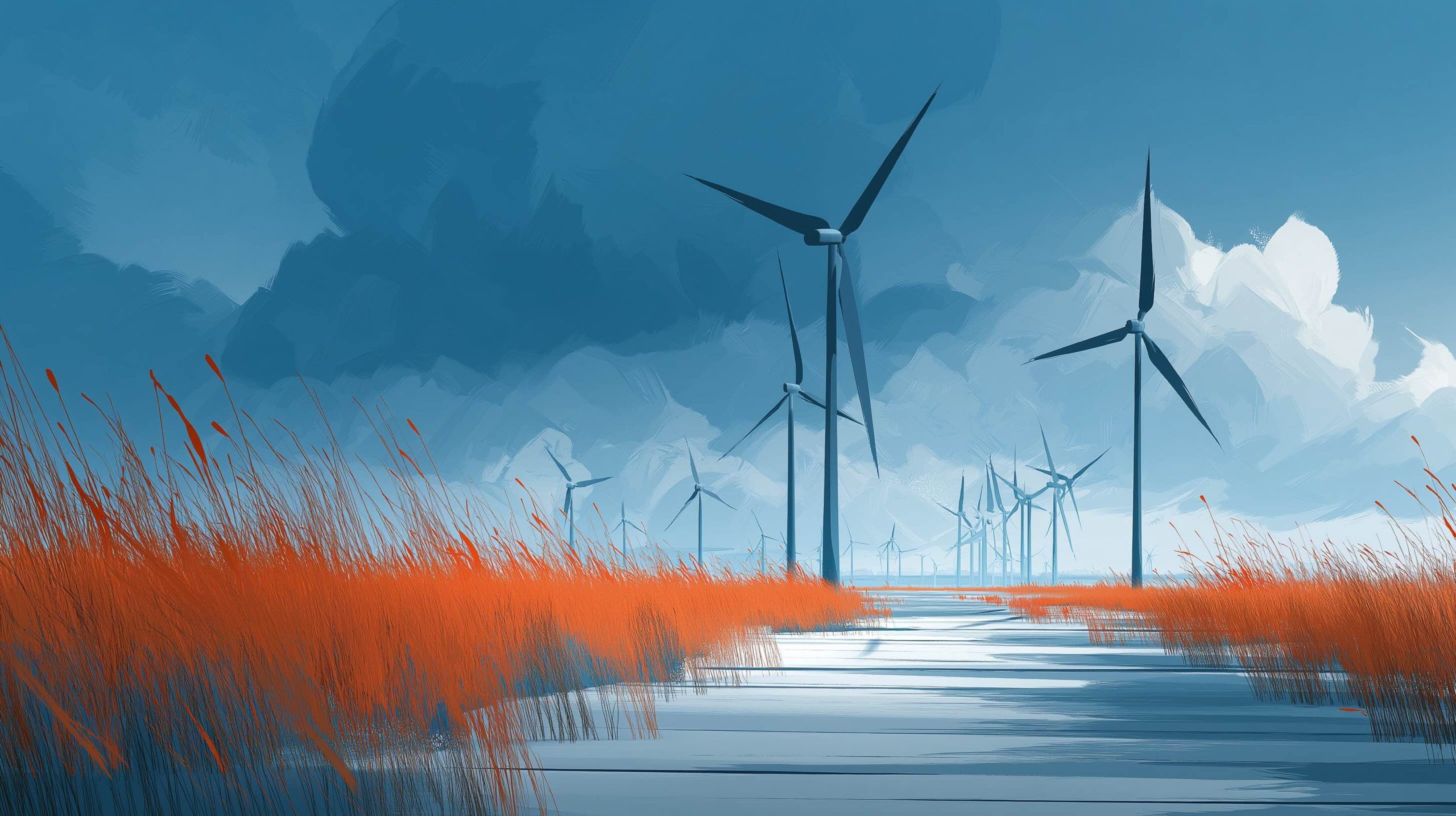- The United Nations’ International Court of Justice on July 23 issued an advisory opinion declaring climate change an urgent and existential threat and urged states to cooperate to achieve concrete emission reduction targets, warning of potential compensation claims for wealthy polluters under international law.
- On July 23, the Trump administration moved to dismantle the EPA’s endangerment finding by arguing federal law does not require carbon emission limits, with a draft proposal to overturn the 2009 finding aiming to derail virtually all U.S. climate pollution rules.
- In the UK, Masdar (UAE) and Iberdrola (Spain) secured £3.6 billion financing for the 1.4 GW East Anglia Three offshore wind farm as part of a €5.2 billion co-development that will power about 1.3 million British homes by late 2026.
- UK data show renewables generated 50.8% of electricity in 2024, a record high driven by wind and solar and declines in coal and gas.
- Republicans in Congress and the White House accelerated the end of federal solar and wind subsidies as part of a budget deal, with stricter tax credit rules threatening about $373 billion in clean energy investments, and projected solar installations down ~17% and wind ~20% over the next decade, while Rhodium Group estimates $263 billion of wind, solar, and battery projects and $110 billion in U.S. clean manufacturing investment imperiled.
- NIO announced on July 24 that its 800,000th electric vehicle rolled off its Hefei factory, an ONVO L90 three-row electric SUV, marking a decade to reach 800,000 and a launch by month’s end.
- QuantumScape and Volkswagen’s PowerCo expanded a partnership to fast-track lithium-metal solid-state batteries, with VW providing up to $131 million in new funding and the QSE-5 pilot production line enabling up to 5 GWh/year capacity.
- GM and Redwood Materials announced a July 23 agreement to repurpose retired EV batteries into energy storage systems, with Redwood integrating second-life GM modules and new cells for data centers and the grid, including GM feeding used Chevy Bolt batteries into a massive microgrid at Redwood’s Nevada campus.
- SWISS and Synhelion began using solar-made jet fuel in regular flights on July 24, delivering a 190-liter barrel for a Hamburg-Zurich flight to cover about 7% of the fuel, with solar fuel life-cycle CO2 emissions over 70% lower and commercial-scale production targeted for 2027.
- In the UK, the HAR1 hydrogen push saw 10 projects signed and shovel-ready, with over £400 million in private investment through 2026, HyMarnham breaking ground, and Kimberly-Clark committing £125 million to two UK hydrogen projects.
Climate Policy & Diplomacy
In a landmark climate ruling, the United Nations’ International Court of Justice (ICJ) declared that climate change poses an “urgent and existential threat” and warned that countries must “cooperate to achieve concrete emission reduction targets” or risk breaching international law [1] [2]. The ICJ’s July 23 advisory opinion – hailed by vulnerable island nations – suggests that failing to meet obligations under treaties like the Paris Agreement could even expose wealthy polluters to future compensation claims by hard-hit countries [3] [4]. “States must cooperate to achieve concrete emission reduction targets,” ICJ Judge Yuji Iwasawa emphasized, underscoring that insufficient action violates the “stringent obligations” of international climate accords [5]. While non-binding, this unprecedented opinion provides a powerful new legal tool for climate accountability, energizing calls for stronger global action.
On the same day, a dramatic U.S. policy shift emerged in Washington. The Trump administration moved to dismantle the EPA’s “endangerment finding” – the scientific foundation for regulating greenhouse gases – by arguing that federal law “does not require” carbon emission limits [6]. A draft EPA proposal reported on July 23 outlines a legal strategy to overturn the 2009 finding that greenhouse gases threaten public health, aiming to derail virtually all U.S. climate pollution limits if successful [7] [8]. This bold bid to rollback climate rules, led by Trump’s energy advisors, would represent his most sweeping assault on climate policy, aligning with an “energy dominance” agenda favoring fossil fuels [9]. Coming just as the world court calls for urgent cooperation, the U.S. move highlights stark divisions in climate governance.
Solar & Wind Energy
Major developments in renewable energy saw both encouraging milestones and serious headwinds. In the United Kingdom, a consortium of Masdar (UAE) and Iberdrola (Spain) achieved financial close on the £3.6 billion financing for the East Anglia Three offshore wind farm (1.4 GW) – one of the world’s largest offshore wind projects [10] [11]. The investment, part of a €5.2 billion co-development deal, will enable construction of a giant North Sea wind farm slated to power 1.3 million British homes by late 2026 [12]. This marks one of the decade’s biggest offshore wind transactions, underscoring continued momentum in Europe’s wind sector even as global targets grow more ambitious. Additionally, new data from the UK showed renewables generated over half (50.8%) of the country’s electricity in 2024 – a record high driven by surging wind and solar output and steep declines in coal and gas use [13].
In the United States, however, the clean energy boom is facing a policy-induced slowdown. On July 24, Reuters reported that Republicans in Congress, backed by President Trump, agreed to accelerate the end of federal solar and wind subsidies as part of a budget deal, reversing much of the prior administration’s support [14]. The White House also ordered stricter rules on remaining tax credits, making far fewer projects eligible [15]. This abrupt U-turn in U.S. renewable policy – after a period of rapid growth fueled by incentives – puts an estimated $373 billion in clean energy investments at risk [16] [17]. Industry analysts warn the changes could slash projected solar installations by ~17% and wind by ~20% over the next decade [18]. Research firm Rhodium Group estimates the new law imperils $263 billion worth of wind, solar, and battery projects plus $110 billion in announced U.S. clean manufacturing investment [19]. “One of the administration’s stated goals was to bring costs down, and as we demonstrated, this bill doesn’t do that,” said Rhodium director Ben King, adding that the policy “is not a recipe for [continued] dominance of the U.S. AI industry” given its impact on power supply [20]. The rollback has already prompted companies to hit pause – for example, a Singapore-based firm scrapped plans to expand a new Indiana solar panel factory, and two permitted offshore wind farms in the Northeast may never be built under the new subsidy rules [21] [22]. Clean energy advocates argue the move will raise prices and cost jobs, even as rival countries press ahead, illustrating how policy decisions are now swinging the fortunes of the renewables sector.
Electric Vehicles & Batteries
It was a momentous week for the electric vehicle industry, with major production milestones and advances in battery technology. Chinese EV maker NIO announced on July 24 that its 800,000th electric vehicle rolled off the assembly line at its Hefei factory – a landmark achievement for the young automaker [23]. NIO’s milestone vehicle was an ONVO L90 three-row electric SUV, a new model aimed at families, which began test drives that same day and is slated to launch by month’s end [24]. “This 800,000 production milestone starts a new chapter for NIO,” the company stated, emphasizing a decade of innovation and expressing commitment to reach one million EVs in the near future [25]. The rapid rise of NIO – reaching 800k units in just 10 years – highlights both China’s EV manufacturing prowess and the intensifying global competition to scale up electric car production.
In the battery sector, a significant collaboration was announced to accelerate next-generation cells. California-based startup QuantumScape, a leader in solid-state battery tech, revealed on July 23 an expanded partnership with Volkswagen’s PowerCo to fast-track commercialization of its lithium-metal solid-state batteries [26] [27]. Under the deal, VW will provide up to $131 million in new funding as QuantumScape hits development milestones on its “QSE-5” pilot production line [28]. The agreement will allow VW’s PowerCo to begin early production of QuantumScape’s advanced cells (with rights to up to 5 GWh/year capacity) and even supply other automakers [29]. QuantumScape’s CEO hailed the “growing strategic, technical and financial alignment” between the companies, calling the high-energy-density solid-state platform a “game-changing” battery breakthrough for the industry [30] [31]. Solid-state batteries promise significantly higher range and faster charging for EVs, and this infusion of funding signals Volkswagen’s confidence in bringing the technology to market in coming years.
Meanwhile, EV battery recycling and reuse took a leap forward through a new partnership. General Motors and JB Straubel’s Redwood Materials signed an agreement (announced July 23) to repurpose retired EV batteries into low-cost energy storage systems [32]. Redwood – founded by Tesla’s former CTO – will integrate both second-life GM EV modules and new cells into stationary storage units aimed at meeting the surging power demands of data centers and the grid [33] [34]. “Electricity demand is accelerating at an unprecedented pace, driven by AI and the rapid electrification of everything… Both GM’s second-life EV batteries and new batteries can be deployed in Redwood’s energy storage systems, delivering fast, flexible power solutions and strengthening America’s energy and manufacturing independence,” said Redwood CEO JB Straubel [35]. The venture includes a new “Redwood Energy” business unit and will support U.S. energy resilience by creating domestic battery supply chains for grid storage [36] [37]. GM is already feeding used Chevy Bolt batteries into a massive microgrid project at Redwood’s Nevada campus – touted as North America’s largest second-life battery installation [38]. This trend of giving EV batteries a second life in energy storage not only reduces waste but also buffers the grid during peak loads, illustrating the converging nexus of EV technology and electricity infrastructure.
Hydrogen Energy
The green hydrogen sector experienced a reality check this week, even as some new projects forge ahead. A Reuters special report on July 23 revealed that developers worldwide are scaling back or cancelling many planned hydrogen projects, citing high costs and a lack of buyers for the zero-carbon fuel [39] [40]. Ambitious targets set in Europe, Australia, and elsewhere are being pared down sharply. Industry data shows only about one-fifth of the EU’s planned hydrogen production capacity for 2030 is likely to actually come online (roughly 12 GW out of a 40 GW target) given current economics [41]. “Green hydrogen was an inflated expectation that has turned into a valley of disillusionment,” admitted Miguel Stilwell d’Andrade, CEO of Portuguese utility EDP, describing how lofty hopes have collided with market reality [42]. Even with government subsidies on offer, many proposed electrolyzer projects have proven unprofitable without guaranteed demand. Major energy firms from Europe to Australia have shelved hydrogen plans – from Iberdrola’s scale-back of its 2030 output goal to oil giants like BP and Shell scrapping hydrogen divisions and projects due to poor economics [43] [44]. Analysts note that sectors once seen as prime customers (steel, freight, chemicals) are finding other decarbonization options or balking at hydrogen’s cost. As a result, the global green hydrogen build-out is entering a slower, more sober phase than the early hype anticipated.
In contrast to these setbacks, the UK government announced a major push for green hydrogen on July 24, signaling progress in one country’s hydrogen rollout. Britain confirmed that 10 projects from its first Hydrogen Allocation Round (HAR1) have now signed contracts and are “shovel-ready” to begin construction, backed by long-term agreements to supply heavy industries with clean hydrogen fuel [45]. These initial commercial-scale projects – located in areas from South Wales and Teesside to Scotland – will use electrolysers to produce low-carbon hydrogen for industries like steel, glass, cement, and trucking, helping them swap out fossil fuels [46] [47]. Over £400 million in private investment is committed to the projects through 2026, with the government providing revenue guarantees via its Low Carbon Hydrogen Agreement contracts [48] [49]. The first of the batch, the HyMarnham project in Nottinghamshire, has already broken ground, converting a former coal power station site into a hydrogen production hub [50]. In a notable corporate commitment, consumer goods giant Kimberly-Clark (maker of Kleenex and Andrex) announced it will invest £125 million in two of the UK hydrogen projects to decarbonize its manufacturing plants – the first major consumer goods firm in Britain to embrace green hydrogen at scale [51]. “This government is rolling out hydrogen at scale for the first time, with 10 of the first projects now powering businesses… Hydrogen will help us cut industrial emissions and support Britain’s industrial renewal,” said UK Industry Minister Sarah Jones, highlighting plans to create thousands of jobs in new hydrogen hubs [52]. The UK is even exploring hydrogen blending into the gas grid to further grow demand [53]. These developments show that despite global challenges, some regions are pressing forward with hydrogen as a cornerstone of their net-zero strategy – though success will depend on driving down costs and securing customers.
Carbon Capture & Storage
Carbon capture and storage (CCS) initiatives also featured in the news, with notable strides in technology deployment. In India, Godrej & Boyce (Godrej Group) announced it has secured its largest-ever international order to manufacture carbon capture equipment for a major project in Europe [54]. The Mumbai-based engineering firm will supply a gigantic absorber system for a European carbon capture, utilization and storage (CCUS) facility – a unit designed for high-efficiency CO₂ separation that surpasses all previous equipment the company has built in size and complexity [55] [56]. This contract, revealed July 23, underscores India’s growing role in the global CCS supply chain, with Godrej’s heavy equipment now being exported to help decarbonize European industries. Godrej says about 70% of its process equipment revenue already comes from international markets, and this project will further cement its position as a key supplier for clean energy infrastructure [57]. “Securing this prestigious order in carbon capture technology… reflects our unwavering commitment to building a cleaner, more resilient future,” said Hussain Shariyarr, head of Godrej’s process equipment division [58]. The news comes amid rising interest in CCS for hard-to-abate sectors like cement and refining. For instance, Europe’s largest oil producer, Norway, is backing large-scale CO₂ storage under the North Sea to serve as a “carbon dump” for the continent’s emissions [59]. And in the U.S., policymakers are advancing frameworks for CO₂ pipeline networks and storage hubs. While CCS faces economic and regulatory hurdles, deals like Godrej’s show tangible progress: critical hardware is being built and deployed to trap carbon emissions at industrial sites, inching carbon capture technology closer to mainstream adoption in the climate fight.
Grid & Infrastructure
Transforming the energy system requires not just generation, but also robust grid infrastructure, and this week brought a mix of expansion and obstruction on that front. In the United States, a high-profile transmission project hit a political roadblock. The Department of Energy confirmed on July 23 that it has canceled a $4.9 billion federal loan guarantee for the planned Grain Belt Express, an 800-mile high-voltage line designed to carry Midwest wind power to eastern states [60] [61]. This Obama-era loan support was yanked by the Trump administration despite its own pledges to expand the grid for rising AI-era electricity demand. The decision, announced the same day as a White House AI energy briefing, stunned many energy experts because Grain Belt would alleviate major grid bottlenecks. “You can’t have it both ways… If you can’t transmit electrons reliably and efficiently, then you’re not going to have energy-intensive industries relying on it,” remarked Senator Thom Tillis (R-NC), criticizing the move’s contradiction with efforts to power new data centers [62]. The Grain Belt Express, crossing multiple farm states, faced local opposition over land easements, and conservative lawmakers like Missouri’s Josh Hawley lobbied hard to block it [63] [64]. By terminating the loan guarantee, the administration has effectively put the nation’s largest renewable transmission line on hold, raising questions about how its goals of grid modernization and “energy dominance” can be met concurrently. Grid advocates note that long-distance transmission is crucial for tapping remote wind and solar resources; the U.S. risks a grid capacity shortfall just as electrification and AI-related demand are surging. The move highlights how partisan politics are now influencing core infrastructure projects needed for the clean energy transition.
Elsewhere, there were bright spots for grid and energy storage development. In Europe, policymakers moved to bolster the grid’s flexibility through hydrogen integration. The UK government said it will study blending hydrogen into the natural gas transmission network, examining if small percentages of hydrogen can be injected into existing gas pipelines [65]. If feasible, this could create new offtake for hydrogen producers and help decarbonize heating and industry by diluting fossil gas with cleaner hydrogen. And in the U.S. Midwest, a novel long-duration storage project got a green light (just before the loan cut news): Wisconsin regulators approved a 10-hour CO₂ battery system by startup Energy Dome, which stores energy by alternately compressing and expanding CO₂ gas – an innovative alternative to lithium batteries [66]. Meanwhile, utility and tech companies continue to invest in grid-scale battery farms. In California, the 200 MW/400 MWh Big Rock lithium-ion battery went into operation to help stabilize the grid during peak hours [67]. And as noted, GM and Redwood’s partnership will repurpose EV batteries into stationary packs to support data center loads [68] [69]. These efforts indicate that despite setbacks like Grain Belt, significant capital is flowing into modernizing the grid and energy storage, recognized as linchpins for a reliable, clean power system. The tug-of-war between expanding grid capacity and political resistance will be an ongoing storyline as the energy transition accelerates.
Sustainable Aviation & Emerging Clean Tech
The past two days also saw breakthroughs in clean fuels and other climate tech innovations. In a world-first for aviation, Swiss International Air Lines (SWISS) and its partner Synhelion announced on July 24 that they have started using solar-made jet fuel in regular flights [70] [71]. SWISS became the first airline to integrate Synhelion’s synthetic “sun-to-liquid” fuel – produced by concentrating sunlight to create syngas that’s refined into kerosene – into a scheduled passenger flight. A 190-liter barrel of this solar fuel was delivered to a Hamburg airport refinery and blended to cover about 7% of the fuel for a SWISS flight from Hamburg to Zurich [72] [73]. While a small proportion, it marks a symbolic and technological milestone in proving that solar fuels can work within today’s aviation infrastructure. “This is the first time that solar fuel has been used in civil aviation. And we are truly proud to be playing such a pioneering role,” said SWISS CEO Jens Fehlinger, calling the maiden batch a “genuine milestone” on the journey to more sustainable flying [74]. Synhelion’s solar fuel, which can cut life-cycle CO₂ emissions by over 70% compared to conventional jet fuel, is expected to ramp up to commercial-scale production by 2027 [75]. The partners are now pursuing certification under EU renewable fuel standards [76]. This development boosts hopes that carbon-neutral e-fuels could eventually decarbonize air travel, alongside biofuels and new engine technologies.
In other tech news, carbon removal innovations earned recognition. Israel’s Airovation Technologies won the 2025 Asper Prize for a breakthrough method to capture CO₂ directly from air and convert it into useful minerals, underlining growing interest in direct-air-capture solutions. And researchers unveiled a new ultra-durable concrete formula (aided by AI design) that not only withstands fire and extreme weather but also absorbs CO₂ from the air, potentially turning buildings into carbon sinks [77]. Such cross-cutting advances – from cleaner jet fuel to carbon-absorbing materials – show the breadth of climate tech progress alongside the headline sectors. They may start small, but each innovation adds a piece to the puzzle of achieving net-zero emissions.
In summary, the news from July 23–24 paints a dynamic picture of the climate and energy tech landscape. We witnessed a historic legal pronouncement on climate duty, major public and private investments in renewables and hydrogen, as well as sobering retrenchments where economics or politics intervened. Electric mobility continues its rapid rise (with new milestones in EV output and battery deals), even as the hard work of building grids and scaling nascent technologies proceeds in fits and starts. The push-pull between climate progress and challenges was on full display: a world court pushing nations to act while some leaders roll back policies; remarkable clean tech firsts achieved even as other projects stall. Together, these developments highlight both the urgency and the complexity of the clean energy transition underway – a transformation being shaped in real time by innovators, governments, and markets around the globe.
Sources: Major news outlets and press releases from July 23–24, 2025, including Reuters [78] [79] [80] [81], Politico [82] [83] [84] [85], Automotive Dive [86], company statements [87] [88] [89], and official reports [90] [91].
References
1. www.reuters.com, 2. www.reuters.com, 3. www.reuters.com, 4. www.reuters.com, 5. www.reuters.com, 6. www.politico.com, 7. www.politico.com, 8. www.politico.com, 9. www.politico.com, 10. masdar.ae, 11. masdar.ae, 12. masdar.ae, 13. www.greenenergytimes.org, 14. www.reuters.com, 15. www.reuters.com, 16. www.reuters.com, 17. www.reuters.com, 18. www.reuters.com, 19. www.reuters.com, 20. www.reuters.com, 21. www.reuters.com, 22. www.reuters.com, 23. www.nio.com, 24. www.nio.com, 25. www.nio.com, 26. www.quantumscape.com, 27. www.quantumscape.com, 28. www.quantumscape.com, 29. www.quantumscape.com, 30. www.quantumscape.com, 31. www.quantumscape.com, 32. www.automotivedive.com, 33. www.automotivedive.com, 34. www.automotivedive.com, 35. www.automotivedive.com, 36. www.automotivedive.com, 37. www.automotivedive.com, 38. www.automotivedive.com, 39. www.reuters.com, 40. www.reuters.com, 41. www.reuters.com, 42. www.reuters.com, 43. www.reuters.com, 44. www.reuters.com, 45. transportandenergy.com, 46. transportandenergy.com, 47. transportandenergy.com, 48. transportandenergy.com, 49. transportandenergy.com, 50. transportandenergy.com, 51. transportandenergy.com, 52. transportandenergy.com, 53. transportandenergy.com, 54. energy.economictimes.indiatimes.com, 55. energy.economictimes.indiatimes.com, 56. energy.economictimes.indiatimes.com, 57. energy.economictimes.indiatimes.com, 58. energy.economictimes.indiatimes.com, 59. www.washingtonpost.com, 60. www.politico.com, 61. www.politico.com, 62. www.politico.com, 63. www.politico.com, 64. www.politico.com, 65. transportandenergy.com, 66. www.energy-storage.news, 67. www.energy-storage.news, 68. www.automotivedive.com, 69. www.automotivedive.com, 70. synhelion.com, 71. synhelion.com, 72. synhelion.com, 73. synhelion.com, 74. synhelion.com, 75. synhelion.com, 76. synhelion.com, 77. www.sciencedaily.com, 78. www.reuters.com, 79. www.reuters.com, 80. www.reuters.com, 81. www.reuters.com, 82. www.politico.com, 83. www.politico.com, 84. www.politico.com, 85. www.politico.com, 86. www.automotivedive.com, 87. www.nio.com, 88. www.quantumscape.com, 89. synhelion.com, 90. www.reuters.com, 91. transportandenergy.com










